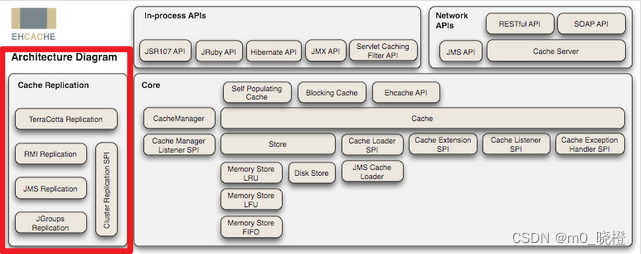一、Ehcache简介
Ehcache是一种广泛使用的开源Java分布式缓存。主要面向通用缓存,Java EE和轻量级容器。它具有内存和磁盘存储,缓存加载器,缓存扩展,缓存异常处理程序,一个gzip缓存servlet过滤器,支持REST和SOAP api等特点。
Ehcache在应用程序中的位置

主要特性
1. 快速
2. 简单
3. 多种缓存策略
4. 缓存数据有两级:内存和磁盘,因此无需担心容量问题
5. 缓存数据会在虚拟机重启的过程中写入磁盘
6. 可以通过RMI、可插入API等方式进行分布式缓存
7. 具有缓存和缓存管理器的侦听接口
8. 支持多缓存管理器实例,以及一个实例的多个缓存区域
9. 提供Hibernate的缓存实现
二、详细配置
1、pom文件中引入依赖坐标
<dependency>
<groupId>org.slf4j</groupId>
<artifactId>slf4j-log4j12</artifactId>
<version>1.6.6</version>
</dependency>
<dependency>
<groupId>net.sf.ehcache</groupId>
<artifactId>ehcache</artifactId>
<version>2.10.6</version>
</dependency>
2、新建配置文件ehcache.xml
<?xml version="1.0" encoding="UTF-8"?>
<ehcache xmlns:xsi="http://www.w3.org/2001/XMLSchema-instance"
xsi:noNamespaceSchemaLocation="http://ehcache.org/ehcache.xsd">
<!--
磁盘存储:将缓存中暂时不使用的对象,转移到硬盘,类似于Windows系统的虚拟内存
path:指定在硬盘上存储对象的路径
-->
<!-- 磁盘缓存位置 -->
<diskStore path="java.io.tmpdir/ehcache"/>
<!--
defaultCache:默认的缓存配置信息,如果不加特殊说明,则所有对象按照此配置项处理
-->
<!-- 默认缓存 -->
<defaultCache
maxEntriesLocalHeap="10000"
eternal="false"
timeToIdleSeconds="120"
timeToLiveSeconds="120"
maxEntriesLocalDisk="10000000"
diskExpiryThreadIntervalSeconds="120"
memoryStoreEvictionPolicy="LRU">
<persistence strategy="localTempSwap"/>
</defaultCache>
<!--
各个熟悉的含义
name 缓存空间名称(非缓存key)
maxElementsInMemory:设置了缓存的上限,最多存储多少个记录对象
maxElementsOnDisk:硬盘中最大缓存对象数,若是0表示无穷大
eternal:true表示对象永不过期,此时会忽略timeToIdleSeconds和timeToLiveSeconds属性,默认为false
overflowToDisk:true表示当内存缓存的对象数目达到了maxElementsInMemory界限后,会把溢出的对象写到硬盘缓存中。注意:如果缓存的对象要写入到硬盘中的话,则该对象必须实现了Serializable接口才行。
diskSpoolBufferSizeMB:磁盘缓存区大小,默认为30MB。每个Cache都应该有自己的一个缓存区。
diskPersistent:是否缓存虚拟机重启期数据,设置成true表示缓存虚拟机重启期数据
diskExpiryThreadIntervalSeconds:磁盘失效线程运行时间间隔,默认为120秒
timeToIdleSeconds: 设定允许对象处于空闲状态的最长时间,以秒为单位。当对象自从最近一次被访问后,如果处于空闲状态的时间超过了timeToIdleSeconds属性值,这个对象就会过期,EHCache将把它从缓存中清空。只有当eternal属性为false,该属性才有效。如果该属性值为0,则表示对象可以无限期地处于空闲状态
timeToLiveSeconds:设定对象允许存在于缓存中的最长时间,以秒为单位。当对象自从被存放到缓存中后,如果处于缓存中的时间超过了 timeToLiveSeconds属性值,这个对象就会过期,EHCache将把它从缓存中清除。只有当eternal属性为false,该属性才有效。如果该属性值为0,则表示对象可以无限期地存在于缓存中。timeToLiveSeconds必须大于timeToIdleSeconds属性,才有意义
memoryStoreEvictionPolicy:当达到maxElementsInMemory限制时,Ehcache将会根据指定的策略去清理内存。可选策略有:LRU(最近最少使用,默认策略)、FIFO(先进先出)、LFU(最少访问次数)。
-->
<!-- helloworld缓存 -->
<cache name="HelloWorldCache"
maxElementsInMemory="1000"
eternal="false"
timeToIdleSeconds="600"
timeToLiveSeconds="600"
overflowToDisk="false"
memoryStoreEvictionPolicy="LRU"/>
</ehcache>
XML文件属性解释
ehcache.xml:里面的注释写的很清楚。
<diskStore> : 当内存缓存中对象数量超过maxElementsInMemory时,将缓存对象写到磁盘缓存中(需对象实现序列化接口)
<diskStore path=""> : 用来配置磁盘缓存使用的物理路径,Ehcache磁盘缓存使用的文件后缀名是*.data和*.index
name : "缓存名称,cache的唯一标识(ehcache会把这个cache放到HashMap里)
maxElementsInMemory : 缓存最大个数。
eternal="false" : 对象是否永久有效,一但设置了,timeout将不起作用。 (必须设置)
maxEntriesLocalHeap="1000" : 堆内存中最大缓存对象数,0没有限制(必须设置)
maxEntriesLocalDisk= "1000" : 硬盘最大缓存个数。
overflowToDisk="false" : 当缓存达到maxElementsInMemory值是,是否允许溢出到磁盘(必须设置)(内存不足时,是否启用磁盘缓存。)
diskSpoolBufferSizeMB : 这个参数设置DiskStore(磁盘缓存)的缓存区大小。默认是30MB。每个Cache都应该有自己的一个缓冲区。
diskPersistent="false" : 磁盘缓存在JVM重新启动时是否保持(默认为false)
timeToIdleSeconds="0" : 导致元素过期的访问间隔(秒为单位),即当缓存闲置n秒后销毁。 当eternal为false时,这个属性才有效,0表示可以永远空闲,默认为0
timeToLiveSeconds="600" : 元素在缓存里存在的时间(秒为单位),即当缓存存活n秒后销毁. 0 表示永远存在不过期
memoryStoreEvictionPolicy="LFU" : 当达到maxElementsInMemory时,如何强制进行驱逐默认使用"最近使用(LRU)"策略,其它还有先入先出FIFO,最少使用LFU,较少使用LRU
diskExpiryThreadIntervalSeconds :磁盘失效线程运行时间间隔,默认是120秒。
clearOnFlush : 内存数量最大时是否清除3、如果是SpringBoot,参考如下:
@Configuration
public class CacheConfig {
//EhCacheManager
@Bean(name = "ehCacheManager")
public CacheManager cacheManager() {
EhCacheManagerFactoryBean cacheManagerFactoryBean = new EhCacheManagerFactoryBean();
cacheManagerFactoryBean.setConfigLocation(new ClassPathResource("ehcache.xml"));
cacheManagerFactoryBean.setShared(true);
cacheManagerFactoryBean.afterPropertiesSet();
return cacheManagerFactoryBean.getObject();
}
}
4、设置缓存
/**
* 设置本地内存
*
* @param key
* @return
*/
@Override
public void setLocalCache(String key, String value, Integer timeout) {
Cache cache = ehCacheManager.getCache("HelloWorldCache");
if (timeout == null) {
timeout = localCacheTimeout;
}
if (value != null) {
Element element = new Element(key, value);
element.setTimeToLive(timeout);
cache.put(element);
}
}
5、获取本地缓存
public String getLocalCache(String key) {
Cache cache = ehCacheManager.getCache("HelloWorldCache");
if (cache == null) {
return null;
}
Element cacheElement = cache.get(key);
if (cacheElement == null) {
return null;
}
return cacheElement.getObjectValue().toString();
}
注意:
6、ehcache 2.x不会主动清除过期缓存,使用定时任务清理缓存
/**
* 定时清除过期本地缓存
**/
@Slf4j
@Configuration
@EnableScheduling
public class ExpireLocalCacheScheduler {
@Qualifier("ehCacheManager")
private CacheManager ehCacheManager
/**
* 10分钟清除一次
*/
@Scheduled(cron = "0 */10 * * * ?")
private void expiredLocalCache() {
try {
Cache cache = ehCacheManager.getCache("HelloWorldCache");
cache.getKeysWithExpiryCheck();
cache.evictExpiredElements()
} catch (Exception e) {
log.error("evictExpiredLocalCache error!", e);
}
}
}
总结
ehcache是java内存结构的缓存,内部结构为java ConcurrentHashMap的重写,ehcache3内部结构为ConcurrentHashMap+WeekRefererce
使用ehcache主要适合两种业务
1、访问次数多Qps特别多,类似web放刷策略
2、需要缓存数据量小
缺点
如果不使用ehcache集群,在项目集群部署的情况下,敏感数据的更新可能不及时。
1、敏感数据不使用ehcache
2、如果使用建议ehcache的过期时间设置的非常小1-10秒






















 408
408











 被折叠的 条评论
为什么被折叠?
被折叠的 条评论
为什么被折叠?








